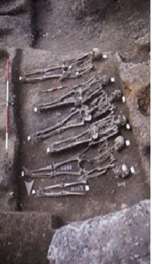Researchers discover origin of the Black Death

(Medical Xpress) -- The bacteria responsible for causing the 1348 Black Death, identified as one of the most cataclysmic events in human history, has been identified by a McMaster researcher.
Using a novel method of DNA enrichment coupled with high-throughput DNA sequencing, Hendrik Poinar, an evolutionary geneticist and member of McMaster's Michael G. DeGroote Institute for Infectious Disease Research (IIDR), graduate student Kirsti Bos and collaborator Johannes Krause of the University of Tubingen have discovered that the now-extinct version of the Yersinia pestis bacterium initiated the bug that caused 30-50 million European deaths between 1347 and 1351. Never before have researchers understood the cause of the plague, which continues to claim some 2,000 deaths a year worldwide.
"The Black Death is arguably one of the most dramatic examples ever of emerging or re-emerging disease," said Poinar, noting his study suggests this plague was the second of three pandemics, starting with the Plague of Justinian in 541 AD and culminating with the 20th century's modern pandemic. "By studying the origin of this disease it may yield information concerning the organism's evolutionary history as a human pathogen."
"Black death killed 50 million people in Europe in 1348 and spread from China through the Middle East to Turkey, Messina, Sicily and into the ports of Genoa and into London and then to Paris," he said. "One-third of the population of Europe died and the question in the beginning was, 'What was the bug that started it?'"
Poinar and Bos discovered that individuals buried at East Smithfield, a mass grave site on the outskirts of London in 1349, harboured Yersinia pestis genes after analyzing the DNA of 109 human skeletal remains. His group also studied the DNA of the remains of 10 humans unearthed at St. Nicholas Shambles, a site pre-dating the Black Death medieval plague.
Preliminary data presented in this work suggest that the Black Death pathogen may be a now-extinct variant. Poinar said the bacteria was thought to be particularly virulent in 1348 and acted on genes that facilitated transmission caused by flea bites, encouraging bacterial proliferation in the respiratory system during bouts of pneumonia.
"Our next goal is to sequence the entire DNA, and I am confident that this new technique will lead to answers that will change our understanding of the history of plague and our concept of emerging and re-emerging diseases," he said.
The research, which appears in Proceedings of the National Academy of Sciences, was supported by an IIDR collaborative grant with collaborators Brian Coombes, assistant professor of biochemistry and biomedical sciences and David Earn, professor of mathematics and statistics. Funding was also received from the Canadian Institutes for Health Research and Social Sciences and Humanities Research Council and Canadian Research Chairs.















